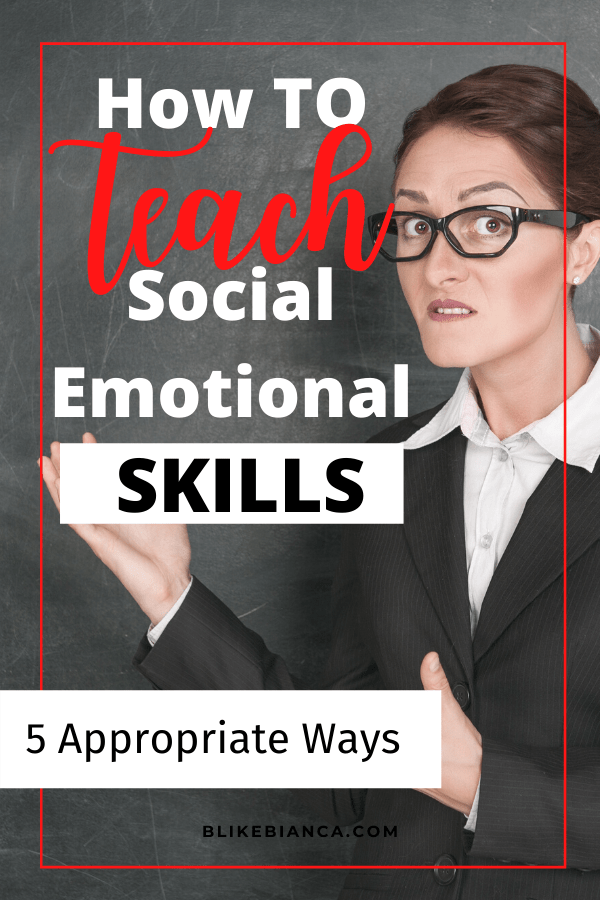Teaching your students how to identify and appropriately express their feelings are social/emotional lessons that can easily be weaved into daily classroom lessons. It is helpful for classroom management and for your own teacher self-care.
After years of teaching social/emotional learning and working with teachers on how to deal with students that have emotional behavior disorders, it’s amazing how patience goes out the door for many teachers.
Through various classroom observations, I’ve noticed teachers that are extremely passive aggressive, sarcastic, and even portray condescending attitudes towards their students-which many students don’t understand. Especially if students are from a different cultural background.
For the most part, interactions like this don’t build connections and relationships for positive behavior growth. Before you prepare to teach students on their own social emotional growth, make sure you are in the right space to do so.

5 Tips to Appropriate Teach Social/Emotional Behaviors
1. Be open and honest about your feelings in your students’ presence. It’s important for your students to see you as a leader and mentor that is healthy and active teacher who appropriately expresses their feelings.
- How you manage your own feelings provides your student’s a simple lesson in how to express their feelings.
- Modeling is one of the most powerful forms of not just teaching in general but teaching behaviors.
2. Show respect. Verbally express your feelings in ways that are helpful and that show respect for to your students. When you openly talk about your emotions and how you are feeling, share them with the class, students will learn how to do it just by observing.
- Use “I” statements followed by “feeling” words when you share your emotions in front of your students.
- For example, “I feel really distracted when you repeatedly tap your pencil on your desk.” You can then give a choice of offering, like a fidget toy.
3. Be mindful of your tone of voice. If you use appropriate tones of voice when expressing feelings, your students will learn to use them as well.For example, instead of raising your voice when you’re upset, make an effort to keep your voice calm. You can use the silent stare, a bell, or even have a place in your classroom where you will always stand that means attention.
4. Identify your young student’s emotions with them. If you teach any group under the of 8 or even a social/emotional class, it’s beneficial to label and clarify the children’s feelings in their presence. They are the most difficult in having an understanding of how their emotions function.
- For example, if a preschooler gets angry and stamps his feet because he wants more playtime, get down to his eye level and say something like, “You’re angry right now because you can’t have playtime is over.”
If it is an older student that is visible and possibly verbally upset, you can silently give them a “break card” to sit in the back of the classroom, hallway, or even a buddy room.
- Use names of feelings, like angry, mad, distracted, happy, tired, busy, frustrated, and others. You convey a great deal of emotional learning when you teach your students about feelings by using the names of emotions. If I’m tired, I let me students know and tell them a possible reason like, “I didn’t sleep well”.
- Sometimes, you may find it helpful to tell your students, “It’s okay if you’re mad.” Giving your student permission to feel and express their feelings can be very validating for them, even if they don’t respond that way at the time.
- On the other hand, if you have a student that is frustrated or angry and throws an object or hits and lashes out, then you have to let them know it’s not OK for them to do XYZ (whatever the action is).” Separate the actions from their emotions and from them as people.
- Remember, it’s pointless for teachers to get frustrated or angry with students who have a lot to learn about their emotions, especially students that have social/emotional services in an IEP (Individualized Education Plan) or are too young to understand. Your patience will show them, by modeling, how to keep their cool, even in a frustrating situation.
5. Reward them. When your child manages their feelings appropriately, providing immediate positive reinforcement makes a big difference in how your student learns to express emotions. Emotional management will often manifest in appropriate behavior.
- Always give class positive feedback for positive behavior, “You all are doing a great job staying focused.”
- When offering positive comments to individual students, state your student’s name and give them a smile. This will show appreciation for their appropriate behavior.
Final Thoughts
Working with your students in learning social emotional appropriate behaviors, can show our students we are human too. We aren’t this magical robot that is happy all the time but we experience life with them.
As we work on building social emotional learning, we must model our natural responses to various scenarios while helping our students learn to manage their emotions early in life. Apply the tips above to help ensure that your students meet not only their academic goals but help them grow into mature adults as well.


2 Comments on How to Appropriately Teach Social Emotional Behavior